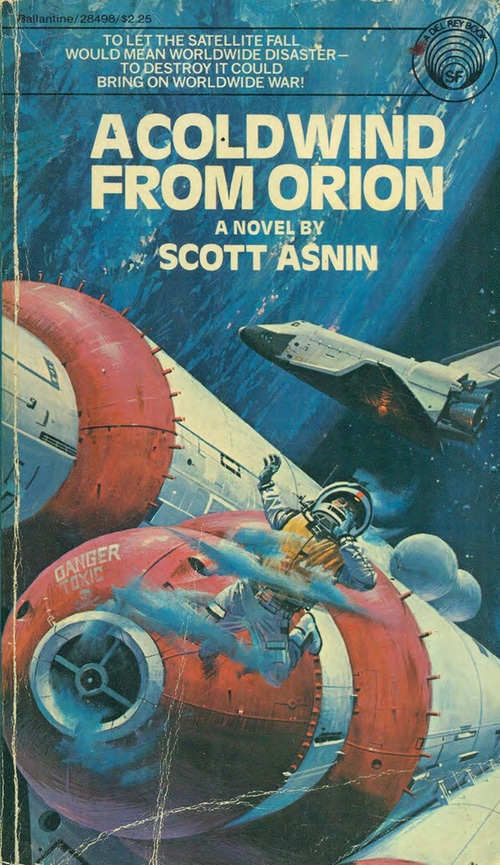Cislunar suspense 2: The Cynthianingby Ken Murphy
|
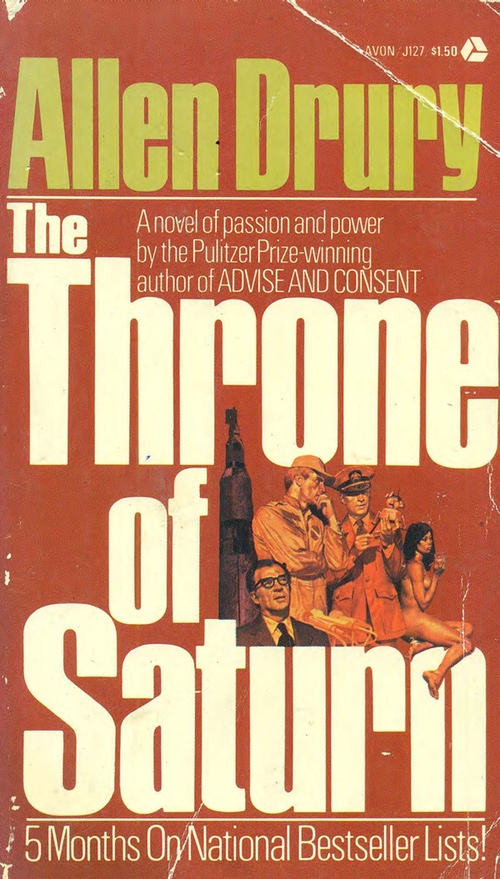 |
1960s
Apollo at Go, Jeff Sutton (1963): A tense imagining of how the first mission to the lunar surface would unfold, with dangers like the asteroid belt around Earth and micrometeoroid sandblasting of the optical glass, making the lunar landing unexpectedly dangerous. What they find there… [GoodReads: 4.00/3]
A World of Difference, Robert Conquest (1964): A group of friends from different backgrounds uncovers a plot by sinister forces to use a mental-force projector on the Moon to ensure that the folks on Earth are thinking the right way. Is humanity doomed to tyranny and slavery? [GoodReads: 2.75/8]
Marooned, Martin Caidin (1964):Major Richard Pruett rides the last Mercury capsule into orbit to gather critical biomedical data for the Gemini and Apollo programs. When it’s time to come home he can’t—the retrorockets fail to fire. So begins a desperate race against time and dwindling oxygen to figure out a way to get the astronaut home. Later adapted into a movie about a trio of astronauts at a space laboratory whose retrorockets also fail to fire. Loaded with technical details and a high-fidelity description of the whole spaceflight process, as well as several annexes of technical data. [GoodReads: 3.58/132]
Mike Mars Around the Moon, Donald A. Wollheim (1964): In a desperate bid to beat the pesky Soviets to the Moon, Mike Mars and his team undertake a secret fly-around of the Moon to prove out the capability for Apollo. But the Soviets are up to no-goodnik, and quickly launch an intercept mission to scatter magnetic mines at the Earth-Moon L-1 point to intercept the returning craft. Will this be the end for our intrepid hero? [GoodReads: 3.33/3]
Twinkle, Twinkle, Killer Kane, William Peter Blatty (1966): An absurdist story of an astronaut who bails during a pre-Moon launch test, and ends up “institutionalized” by authorities to get his head straight so the mission can continue. A slight study of religious concepts of evil in men, later re-worked as “The Ninth Configuration”, which was made into a really dull movie. [GoodReads: 3.61/650]
Four Came Back, Martin Caidin (1968): When the Earth’s orbit intersects a gas/dust cloud passing through the solar system, space station Epsilon retrieves samples, leading to a terrifying biocontamination of the facility. Earthlings promptly panic at the thought of a plague from space. Will any of the crew survive? [GoodReads: 2.89/19]
Countdown, Frank G. Slaughter (1970): A doctor is sent to Cape Kennedy to look into the mental health of those involved with the successor to Apollo: the Pegasus program. What he finds are many of the same dysfunctions he saw in the earliest days of the space program, but stewed together in a more potently toxic mix, one that threatens the future of the program and some folks don’t want that getting out. [GoodReads: 3.00/19]
The Throne of Saturn, Allen Drury (1970): In the aftermath of Apollo, it’s time for the next step: a trip to Mars. This is the story of Planetary Fleet One (PiFY-1) and all of the social and political messes associated with such an effort. And the Soviets, of course, are up to no-goodnik, leading to a showdown on the Moon. [GoodReads: 3.41/83] {h/t Jose C}
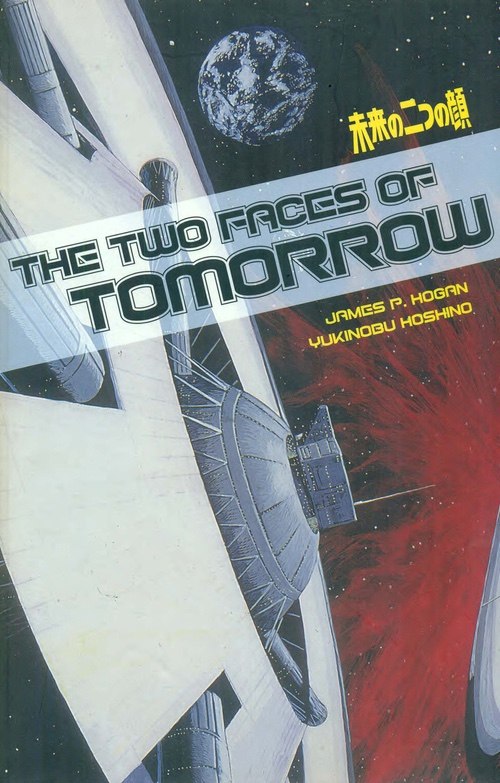 |
1970s
The Dead Astronaut, Playboy Science Fiction (1971): A number of short stories from the magazine, many grim, about efforts to spread out into cislunar space (and beyond), all written before the first Moon landing. [GoodReads: 3.38/32]
The Falling Astronauts, Barry N. Malzberg (1971): An astronaut orbiting the Moon while his colleagues work below has his thumb poised over the button that will ignite the engines and send him home. Mission Control is frantic, and the rippled effects threaten the whole space program. A rather cynical look at the space program. [GoodReads: 3.95/38]
Stormtrack, James Sutherland (1974): Paranoia reigns aboard the Boreas space station, tasked with monitoring the weather on Earth. Ross Moran finds himself plucked from the public dole to make good use of his meteorology degree. He quickly finds that factions are feuding, leading to a deadly standoff in what is developing as a nice spy mystery and then meh, aliens, teleporters, whatever. [GoodReads: 2.75/4]
The Moonlovers, Olaf Lornquest (1975): An astronaut finds that his lover has stowed away for a trip to space, and the mass differential creates perturbations in the orbit that send the capsule to the Moon, with ample opportunity for sexy-time on the way. They crash, but find a facility on the Moon’s surface where they can seek refuge. Eventually, they end up in the hands of a Soviet crew of women and their devious plots and machinations (more sexy time). Will the astronaut ever get home to his wife? [GoodReads: 2.50/2]
Colony, Ben Bova (1978): Aboard Island One, David Adams is the first genetically engineered human, free of disease with a super brain and the body to match. All his life he’s known only Island One, but cannot go to Earth because of the risks he’d face. So he runs away by way of the Moon to finally arrive on Earth, right in the middle of a societal breakdown on a global scale. Corporations and governments vie for control, while revolutionaries throw some chaos in the mix. A struggle that even extends to Island One, where corporate masters, government agents, and radical revolutionaries face off for ultimate control. [GoodReads: 3.61/918]
The Hermes Fall, John Baxter (1978): The Orbiter Enterprise unknowingly spots asteroid 69230 Hermes (a/k/a 1937 UB) on a collision course with Earth. A journalist figures out we’ve only got five days before the huge nickel-iron body impacts Earth. A desperate launch of a Saturn to intercept with a nuke is scrambled… can they get there in time? [GoodReads: 3.57/14]
The Two Faces of Tomorrow, James P. Hogan (1979): In the near-future computers are taking over ever more complicated tasks. After an “oopsie” on the Moon, it is decided to stress-test the advanced systems on a converted space Island to figure out if there is anything to fear from the increasingly sophisticated systems that run our world. There may well be… In 2006 it was adapted by Yukinobu Hoshino into a manga-style graphic novel. [GoodReads: 3.90/683]
The Web Between the Worlds, Charles Sheffield (1979): Published not too long after Arthur C. Clarke’s seminal work The Fountains of Paradise, here the space elevator serves as the mechanism whereby horrible secrets are revealed, and a drama that crosses generations that ends in fire. The mechanism the author uses for emplacement of the elevator is rather creative, and he introduces an asteroid mining concept further fleshed out in his excellent juvenile Higher Education. [GoodReads: 3.65/237]
A Cold Wind from Orion, Scott Asnin (1980): A long abandoned biological experiment aboard a defunct space station threatens to tumble uncontrollably into the atmosphere. Only a desperate shuttle mission can hope to avert a tragedy of a pathogen, rendered hyper-lethal by the radiation environment of space, dispersed into the atmosphere. [GoodReads: 3.00/10]
Shiva Descending, Gregory Benford & William Rotsler (1980): A massive meteor impact leads scientists to figure out that there’s more on the way, with a giant in the mix named Shiva. Word gets out and society starts descending into chaos, while a desperate mission to intercept the giant meteoroid is undertaken. Murphy’s Law as always rears its ugly head, and things get very desperate indeed. [GoodReads: 3.47/119]
Shuttle Down, Lee Correy (1980–81): During the launch of Shuttle Atlantis from Vandenberg to take Landsat-13 to a sun-synchronous polar orbit, the shuttle’s main engine’s abruptly, too late for a return to the launch site, but too early to make it to orbit. So they end up barely making it to Easter Island/Isla de Pascua/Rapa Nui and getting stuck on the runway. While the logistical challenge of getting the strongback out into the middle of nowhere and mounting the shuttle on a 747 are great, they pale next to the administrative, bureaucratic, cultural, and diplomatic challenges facing the effort. Plus the Soviets are up to no-goodnik. A cautionary logistics tale for those who promote distant and isolated space facilities. [GoodReads: 3.44/34] {h/t Royce Day}
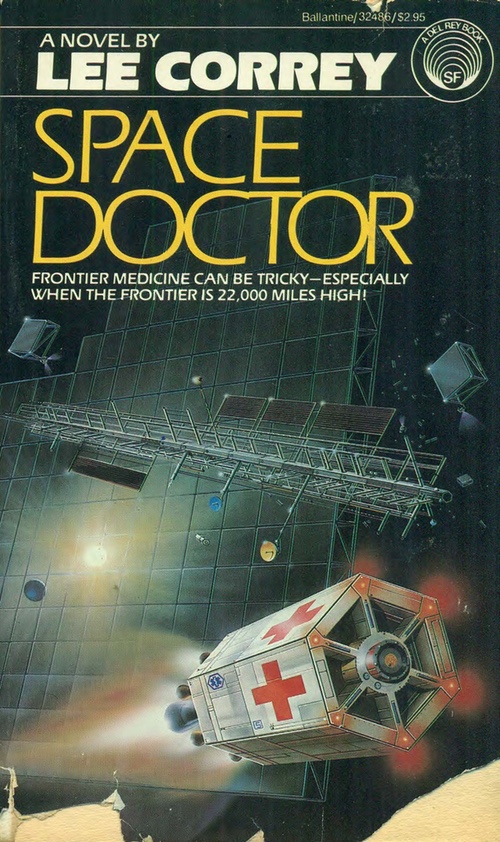 |
1980s
Space Doctor, Lee Correy (1981): A doctor who always thought of himself as a frontier practitioner in the American West is tasked with setting up a hospital facility at a GEO construction site where 150 workers have been forecasted to die. How many workers can he save? Not all of them, but he does quickly figure out he needs an ambulance. A space ambulance! [GoodReads: 3.41/41]
Tom Swift – The City in the Stars, Victor Appleton (1981): Young Tom Swift is testing a new fusion drive for his racer at the Island colony New America when the engine blows up. Did he not get the design right, or are there more sinister forces at work? [GoodReads: 4.04/80]
Worlds, Joe Haldeman (1981): A kind of reverse travelogue, a resident of the New New York “World” (the author’s word for Islands) goes to Earth for academic studies. Whilst there, she gets mixed up with some shady characters maneuvering humanity to the edge of apocalypse, one that will leave the orbital colonies with the upper hand in the future. Similar in some ways to Ben Bova’s Colony. [GoodReads: 3.49/842]
The Descent of Anansi, Larry Niven & Steven Barnes (1982): A cargo run to drop off a special shipment of silicon bismide crystal filament manufactured out near the Moon (there’s lots and lots of silicon on the Moon) is intercepted in LEO. Seems that there are piratical (sorry, corporate) interests that want the goodies for themselves. Can the crew save the delivery, or even themselves? [GoodReads: 3.32/590]
Manna, Lee Correy (1983): At the dawn of the new millennium, a small East African state declares its independence as the United Mitanni Commonwealth with the aim of creating a libertarian utopia. Fifty years on, the fruits of liberty are blossoming, and the nation hosts one of the most active spaceports on Earth, and a high level of intellectual and material prosperity. A US Aerospace pilot, drummed out of the service, has taken on a job as a cargo pilot. Since not everyone is on board with the whole idea of people being free to live the lives they choose, but rather insist that everyone should be directed and controlled to whatever ends, Mitanni finds itself under attack by nefarious forces and its citizens must make a stand as free men to protect what they have created. In doing so, they may unlock the abundant resources of the solar system to rain as manna from the heavens unto the Earth and so enriching everyone. One of the first novels I’ve seen that looks at the idea of economics of abundance (sourcing materials and energy from the solar system) as compared with our current economics of scarcity (sole-sourcing everything from Earth). [GoodReads: 3.50/12]
Schismatrix, Bruce Sterling (1985): In a technologically advanced future, Mechanists focus on machine-aided developments, while the Shapers rely on biological technology. Failed revolutionary Abelard Lindsay plots and conspires his way across cislunar space and into the Solar system in a transhumanist future spanning many, many decades. [GoodReads: 3.90/1,179]
The Third Fury, Russell Rhodes (1985): The US, working in conjunction with a news media mogul, has devised a way to turn off US military hardware in the hands of others. Terrorists figure out how to exploit this, with the intent of turning the Middle East into a bloodbath during war exercises. [GoodReads: 0.00/0]
Circuit, Melinda M. Snodgrass (1986): Politicians in Washington want to cement their control of activities in space and so create the 15th Circuit Court, held at the EnerSun 1 SPS facilities in GEO. Cabot Huntington is appointed by the President to be a good puppet and make the “right” decisions. Of course, the President soon steps over the line and Justice Huntington finds himself in an ethical quandary. Can real justice be served on the high frontier? [GoodReads: 3.60/30]
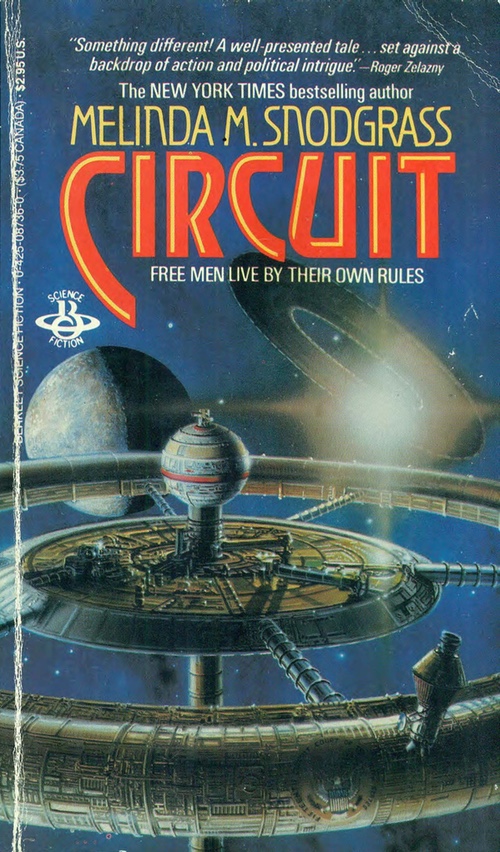 |
The Omega Command, Jon Land (1986): In orbit, the shuttle Adventurer is destroyed by an unknown assailant. In New York City, a deep state agent is assassinated in a brothel. Someone has initiated a plan to take over the US, one so insidiously planned that it just might succeed. [GoodReads: 3.84/251]
Zoboa, Martin Caidin (1986): Terrorists have hijacked some nukes and intend to put on a show at the launch of the next generation space shuttle. Can a rag-tag bunch of “crazy” (yeah, like a fox) air show pilots save the day? [GoodReads: 3.24/17]
Kill Ratio, Janet Morris & David Drake (1987): A genetically-engineered virus kills every Arab at the United Nations headquarters on the Moon in a matter of hours. But this is just the test for a far more genocidal plot by racist psychopaths in positions of power around the globe. Can they be stopped? [GoodReads: 3.33/54] {h/t Density Duck}
Space Station ICE-3, Bruce Coville (1987): A gripping tale of young Rusty McPhee, a lifetime resident of International Colonization Effort 3 at one of the Lagrange points. One day he accidently sees a dead body in the nutrient tanks, he tells the wrong people, and soon finds himself in jeopardy from those with secrets to keep. [GoodReads: 3.72/32]
Vacuum Flowers, Michael Swanwick (1987): Our protagonist awakens with a new personality overlay, and quickly has corporations and the underworld in hot pursuit in cislunar space and out into the Solar system. Part of the cyberpunk genre (q.v. Rudy Rucker’s works) where humans are programmable wetware. [GoodReads: 3.85/1,024]
Winter Hawk, Craig Thomas (1987): When US intelligence receives word from a deep plant in Baikonur that the Soviets are about to launch some new kind of weapon on the eve of signing a nuclear reduction accord with the US, they scramble to find a way to extract the agent and any info they have. What results is super-helicopter-pilot Mitchell Gant undertaking a deep probe of Soviet airspace in a desperate race against time. [GoodReads: 3.65/345]
Zero Gravity, Richard Lourie (1987): With the technological achievement of a Moon landing, it’s time for a cultural achievement, leading the Yanks and Soviets to each send a poet to the Moon. Hijinks ensue. [GoodReads: 4.00/5]
Murder by QRM, Walker A. Tompkins (1988)L Young Tommy Rockford, aka K6ATX, has gotten a request for a special visit by NASA on a matter of urgent national security. The Shuttle will be launching from Vanderhoff, and they’re worried about recent launch failures and spurious self-destruct signals. Does someone have it in for the Shuttle? Enough to commit Murder by QRM? [GoodReads: 5.00/2]
The Big Lifters, Dean Ing (1988): John Wesley Peel, traumatized in his youth by a big rig accident, has been working on better delivery systems that make our roadways safer. In the process, his team figures out how to better launch freight to orbit, changing yet another industry. [GoodReads: 3.44/45]
